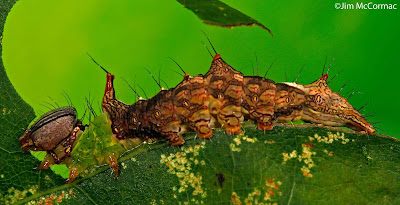Most of the group of roughly 25 people poses above, in front of the Eulett Center, smack in the middle of the Ohio Chapter of The Nature Conservancy's sprawling Edge of Appalachia Preserve in Adams County (photo by David Hughes). Thanks to Chris Bedel, as always, for allowing us to invade the center! Major props to Mary Ann Barnett and Deb Bradley, who did the lion's share of planning and logistics. Ditto to John Howard, who gave a program, AND led field trips, AND selflessly shared his vast reservoir of knowledge. We also appreciate the hospitality of Randy Lakes, who allowed us to conduct nocturnal forays on his fabulous piece of property. Diane Brooks kindly brought some interesting livestock for the group to see, and helped tremendously with identifications. EVERYONE contributed in some way, especially when it came to finding interesting caterpillars in the gloom of night.
I bet we could have had 80 people attend, but space precluded that, as did a paucity of experienced caterpillar guides. This was also a trial run of sorts; it worked so well that I suspect we will try this again next September.
Photo: Judy Ganance
Both Saturday and Sunday nights, we were out in the field until the wee hours. Most caterpillars are nocturnal, so we had to become night creatures as well. A good chunk of daylight hours was spent identifying and photographing animals that we brought back to the Eulett Center. It served as an outstanding base camp. In all, about 66 species of caterpillars were wrangled and inspected, and we didn't bring back all of the species that we found. Amazingly, and thanks to good care, there was not a single case of mortality while in captivity (that I know of) and all cats were released back to the wild after the workshop.
So, I'd like to share some photos of some of the tubular prizes that we encountered. Text for each depicted species will be brief - this is more of a visual post.
On Saturday, word leaked from the kitchen that the chef preparing dinner had discovered "worms" in the kale. Yes! said I - bring me some! Turned out they were Cross-striped Cabbageworms, Evergestis rimosalis, a beautiful little caterpillar that feeds on mustards. We were quite pleased to see them, and photos were made. This was perhaps the only gathering where such a food infestation would be welcome!
Slightly backlit to showcase its fluffy elegance, this is the penultimate instar of the Black-waved Flannel Moth caterpillar, Lagoa crispata. In its next and final instar (an instar is a growth stage, morphed into by molting the skin), the caterpillar will be brown, not nearly so fluffy, and look like some other species.
A work of art indeed, the Canadian Owlet caterpillar, Calyptra canadensis. They feed on meadow-rue (genus Thalictrum)
Suction-cup feet rimmed with sharp hooks known as crochets are how caterpillars stick to twigs and leaves like glue. This is the underside of a White-marked Tussock Moth caterpillar, Orgyia leucostigma.
A Checkered-fringe Prominent, Schizura ipomoea, rasps away. This one is a great leaf edge mimic.
Bizarre but stunning, the Crowned Slug, Isa textua, always gets a reaction. This one, unfortunately, is a walking dead caterpillar. That little white ovoid dot is the shell of a tachinid fly egg. The parasitoid's grub is inside the caterpillar, eating away its innards. This is a very common fate for caterpillars.
We're confronted by the strange snakish face of an Eastern Tiger Swallowtail caterpillar, Papilio glaucus. The orange projections are horns known as osmeteria; when exerted they exude a foul odor. When confronted by a songbird or some other threat, the caterpillar flips out these chemical switchblades.
The Fawn Sphinx, Sphinx kalmiae, is possibly the showiest of the sphinx moth caterpillars, and it has a lot of competition. Note its black-speckled blue tail. This one is a specialist on ash.
Many of you have probably seen the beautiful pink and yellow Rosy Maple Moth, Dryocampa rubicunda. This is its caterpillar, which is known as the Green-striped Mapleworm. Thanks to Diane Brooks for bringing them along. To see a photo of the adult moth, CLICK HERE.
Just magnificent, and a photographer's dream. Here we have a Honey Locust Moth caterpillar, Sphingicampa bicolor. I'll leave you to guess what it eats.
There's a lot more images where these came from, and I'll post some more of them soon.












4 comments:
What a fun time. I have only seen most of these moths in pictures. This makes me want to get out and explore more to find them.
Caterpalooza? Larvapalooza? Cater-Fest?
Wow, these pictures are fantastic!! Thanks for sharing (and identifying) them!
What a wonderful post to read, especially with inch after inch of chilly lake effect rain coming down on us Clevelanders tonight. Your photos are absolutely fabulous, and I always enjoy your splendidly-creative descriptive phrases. "Tubular prizes," and "food infestation" are among my favorites!
Post a Comment